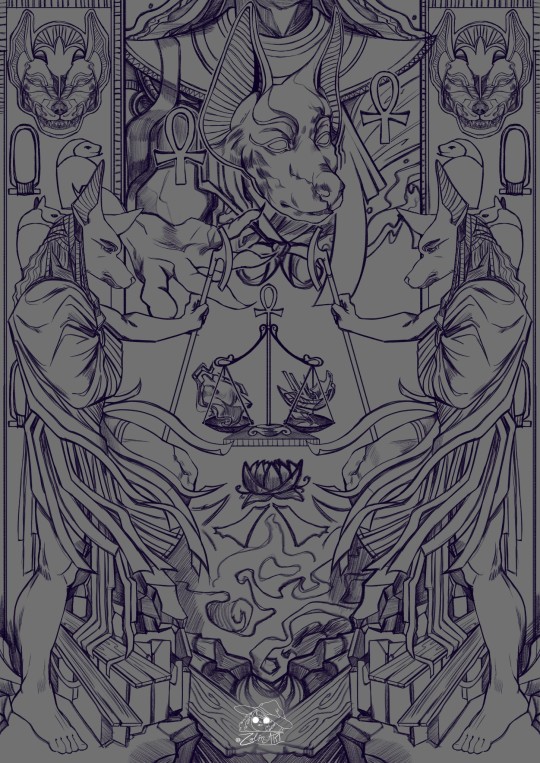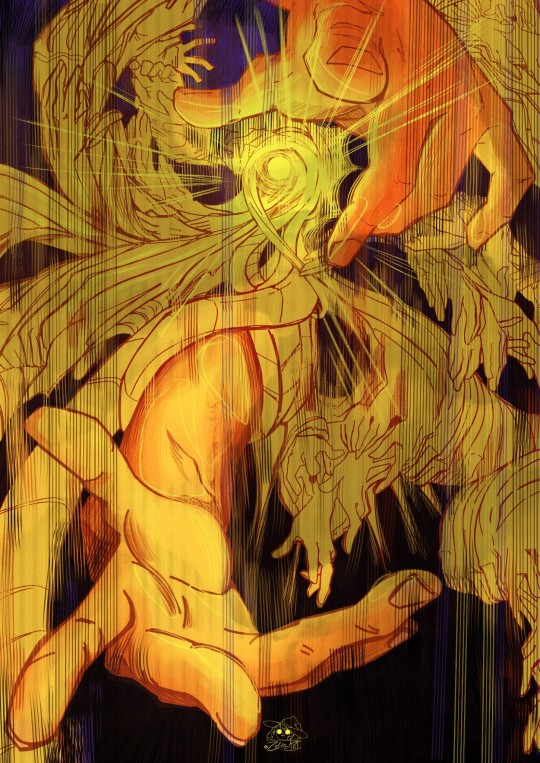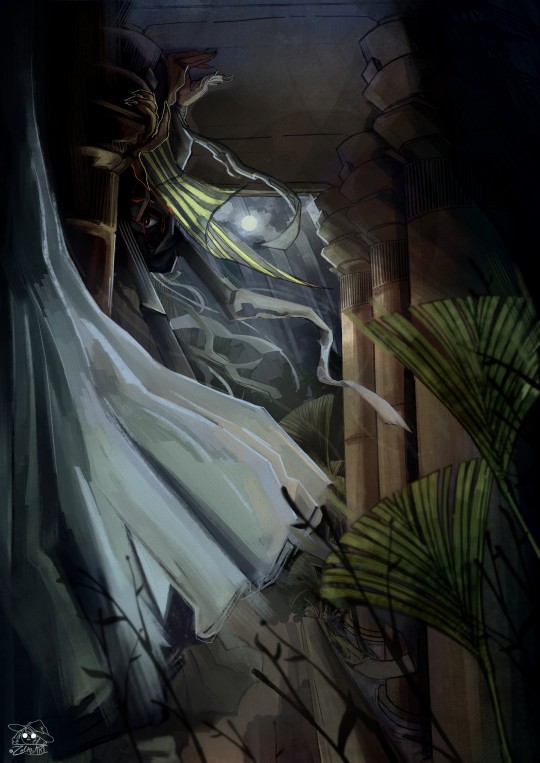#ancient god
Text
I had this little fantasy and I can't get it out of my head.
I'm not religious by any means, but for some reason I like the idea of some ancient god who can hear prayers and pleas of his worshippers.
And one day... he would catch a very interesting prayer 😏
Also, I'm imagining a god of primal urges or something like that but you can imagine whoever you want.
(It's gonna get naugty after the cut, so hear my warning.) 18+
The pleas he hears are usually selfish pleas for wealth, security, fame or love. He doesn't often hear pleas that involve someone else.
Fathers, mothers, children, kings and paupers... all want something for themselves and no one else. Until a special prayer and plea reaches his ears. A prayer that he as a god will never be forgotten. Prayers for him to always be well and always be satisfied. Pleading with him that, like their god, who does all good things for all, he to indulge in rest and the beauty of the world.
At first he is surprised, but then out of curiosity he finds that person who has such prayers. Finding the sweetest little thing he ever saw. Innocent and beautiful.
He also finds that she offer sacrifices to him in the form of the best wine, fruit and small ornaments that she make herself. He is really happy with this little worshipper and from that moment on he listens to her prayers every night.
But the longer he listens, the more her prayers begin to change to sometimes not so innocent. Praying for him to get any pleasure he seeks. Offering him her mouth and other holes to achieve his satisfaction as he pleases. Promising that if he gave her the opportunity, she would worship not only him as a god but also his body, his cock.
In the end, he can't take it anymore and shows himself to his little worshipper. Accepting her offerings and giving her the opportunity to worship him as she said she would.
She would feed him, pour him wine, and while he ate, she would slide to her knees, taking his cock into the warmth of her mouth, gently kissing it or mapping the veins with her tongue. Mumbling her praise for his cock, for his strong legs and thighs, which she gently massaged with her hands. Eagerly drinking his cum. Thanking him for such an honor.
Later he would fuck her, hard and rough, while listening to her moan his name. Thanking him for deciding to accept her offerings. Promising that her pussy is just for him to fuck because he deserves it like her god.
He would call her "Little worshipper" or "Little one"
Maybe even "My sweetest offering" or just "Darling"
I imagine that when he fucks, he grunts and makes a primal growls like an animal. Biting her and basically crushing her hips or legs in his hands when he's close to cumming.
So that's it, that's the idea. I don't know why, but there's something about the idea of an ancient god letting me worship him and then rewarding me by basically fucking my brains out 🤷🏻♀️😅
#smut#nsft idea#ancient god#ancient god x f!human#can it be classified as monster smut?#worshipping#worshiping an ancient god#monster smut#monsterfucker
426 notes
·
View notes
Text

"I am a god, and you were born to follow!" ☄️
#ruckis vandalizes#nonfandom oc#nonfandom#art#artists on tumblr#order of the stars#illustration#traditional drawing#drawing#original character#oc#anthro#kitsune#kitsuneoctua#furry#anthropamorphic#primordial god#god oc#goddess#fox furry#ancient god
24 notes
·
View notes
Text





Egyptian Gods; Amun-Amunet, Anubis, Aten, Bastet and Medjed
5 complete and still need 29 Illustrations to finish this serie, probably I'm gonna die before to finish it but I'm gonna find out in the middle of the road or sm
#digital art#digital drawing#ilustración digital#egyptian mythology#egyptian gods#ancient god#aten egyptian god#bastet#Anubis#Amun#amunet#medjed
51 notes
·
View notes
Text

Ancient God
319 notes
·
View notes
Text
Eldritch god (self-diagnosed)
11 notes
·
View notes
Text
So who is Baal?
Baal or Baʻal, was a title and honorific meaning 'owner', 'lord' in the Northwest Semitic languages spoken in the Levant during antiquity.
Baal is a God of fertility, weather, rain, wind, lightning, seasons, war, sailors and so on.
Baal worship is also called Baalism.

Solid cast bronze of a votive figurine representing the god Baal discovered at Tel Megiddo, dating to the mid-2nd millennium BC.
His holy symbols are bull, ram and thunderbolt.
Baal was worshipped in ancient Syria, especially Halab, near, around and at Ugarit, Canaan, North Africa and Middle Kingdom of Egypt.
Baʿal is well-attested in surviving inscriptions and was popular in theophoric names throughout the Levant but he is usually mentioned along with other gods, "his own field of action being seldom defined". Nonetheless, Ugaritic records show him as a weather god, with particular power over lightning, wind, rain, and fertility. The dry summers of the area were explained as Baʿal's time in the underworld and his return in autumn was said to cause the storms which revived the land. Thus, the worship of Baʿal in Canaan—where he eventually supplanted El as the leader of the gods and patron of kingship—was connected to the regions' dependence on rainfall for its agriculture, unlike Egypt and Mesopotamia, which focused on irrigation from their major rivers. Anxiety about the availability of water for crops and trees increased the importance of his cult, which focused attention on his role as a rain god. He was also called upon during battle, showing that he was thought to intervene actively in the world of man, unlike the more aloof El. The Lebanese city of Baalbeck was named after Baal.
The Baʿal of Ugarit was the epithet of Hadad but as the time passed, the epithet became the god's name while Hadad became the epithet. Baʿal was usually said to be the son of Dagan, but appears as one of the sons of El in Ugaritic sources. Both Baʿal and El were associated with the bull in Ugaritic texts, as it symbolized both strength and fertility. He held special enmity against snakes, both on their own and as representatives of Yammu (lit. "Sea"), the Canaanite sea god and river god. He fought the Tannin (Tunnanu), the "Twisted Serpent" (Bṭn ʿqltn), "Lotan the Fugitive Serpent" (Ltn Bṭn Brḥ, the biblical Leviathan), and the "Mighty One with Seven Heads" (Šlyṭ D.šbʿt Rašm). Baʿal's conflict with Yammu is now generally regarded as the prototype of the vision recorded in the 7th chapter of the biblicalBook of Daniel. As vanquisher of the sea, Baʿal was regarded by the Canaanites and Phoenicians as the patron of sailors and sea-going merchants. As vanquisher of Mot, the Canaanite death god, he was known as Baʿal Rāpiʾuma (Bʿl Rpu) and regarded as the leader of the Rephaim (Rpum), the ancestral spirits, particularly those of ruling dynasties.
From Canaan, worship of Baʿal spread to Egypt by the Middle Kingdom and throughout the Mediterranean following the waves of Phoenician colonization in the early 1st millennium BCE. He was described with diverse epithets and, before Ugarit was rediscovered, it was supposed that these referred to distinct local gods. However, as explained by Day, the texts at Ugarit revealed that they were considered "local manifestations of this particular deity, analogous to the local manifestations of the Virgin Mary in the Roman Catholic Church". In those inscriptions, he is frequently described as "Victorious Baʿal" (Aliyn or ẢlỈyn Baʿal), "Mightiest one" (Aliy or ʿAly) or "Mightiest of the Heroes" (Aliy Qrdm), "The Powerful One" (Dmrn), and in his role as patron of the city "Baʿal of Ugarit" (Baʿal Ugarit). As Baʿal Zaphon (Baʿal Ṣapunu), he was particularly associated with his palace atop Jebel Aqra (the ancient Mount Ṣapānu and classical Mons Casius). He is also mentioned as "Winged Baʿal" (Bʿl Knp) and "Baʿal of the Arrows" (Bʿl Ḥẓ). Phoenician and Aramaic inscriptions describe "Baʿal of the Mace" (Bʿl Krntryš), "Baʿal of the Lebanon" (Bʿl Lbnn), "Baʿal of Sidon" (Bʿl Ṣdn), Bʿl Ṣmd, "Baʿal of the Heavens" (Baʿal Shamem or Shamayin), Baʿal ʾAddir (Bʿl ʾdr), Baʿal Hammon (Baʿal Ḥamon), Bʿl Mgnm.
The epithet Hammon is obscure. Most often, it is connected with the NW Semitic ḥammān ("brazier") and associated with a role as a sun god. Renan and Gibson linked it to Hammon (modern Umm el-‘Amed between Tyre in Lebanon and Acre in Israel) and Cross and Lipiński to Haman or Khamōn, the classical Mount Amanus and modern Nur Mountains, which separate northern Syria from southeastern Cilicia.
The major source of our direct knowledge of this Canaanite deity comes from the Ras Shamra tablets, discovered in northern Syria in 1958, which record fragments of a mythological story known to scholars as the Baal Cycle. Here, he earns his position as the champion and ruler of the gods. The fragmentary text seems to indicate a feud between him and his father El as background. El chooses the fearsome sea god Yam to reign as king of the gods. Yam rules harshly, and the other deities cry out to Ashera, called Lady of the Sea, to aid. Ashera offers herself as a sacrifice if Yam will ease his grip on her children. He agrees, but Baal opposes such a scheme and boldly declares he will defeat Yam even though El declares that he must subject himself to Yam.
With the aid of magical weapons given to him by the divine craftsman Kothar-wa-Khasis, Baal defeats Yam and is declared victorious. He then builds a house on Mount Saphon, today known as Jebel al-Aqra. (This mountain, 1780 meters high, stands only 15 km north of the site of Ugarit, clearly visible from the city itself.)
Lo, also it is the time of His rain.
Baal sets the season,
And gives forth His voice from the clouds.
He flashes lightning to the earth.
As a house of cedars let Him complete it,
Or a house of bricks let Him erect it!
Let it be told to Aliyan Baal:
'The mountains will bring Thee much silver.
The hills, the choicest of gold;
The mines will bring Thee precious stones,
And build a house of silver and gold.
A house of lapis gems!'
However, the god of the underworld, Mot, soon lures Baal to his death, spelling ruin for the land. His sister Anat retrieves his body and begs Mot to revive him. When her pleas are rebuffed, Anat assaults Mot, ripping him to pieces and scattering his remains like fertilizer over the fields.
El, in the meantime, has had a dream in which fertility returned to the land, suggesting that Baal was not indeed dead. Eventually he is restored. However, Mot too has revived and mounts a new attack against him.
They shake each other like Gemar-beasts,
Mavet [Mot] is strong, Baal is strong.
They gore each other like buffaloes,
Mavet is strong, Baal is strong.
They bite like serpents,
Mavet is strong, Baal is strong.
They kick like racing beasts,
Mavet is down. Baal is down.
After this titanic battle, neither side has completely prevailed. Knowing that the other gods now support Baal and fearing El's wrath, Mot finally bows before him, leaving him in possession of the land and the undisputed regent of the gods.
Baal is thus the archetypal fertility deity. His death signals drought and his resurrection, and brings both rain and new life. He is also the vanquisher of death. His role as a maker of rain would be particularly important in the relatively arid area of Palestine, where no mighty river such as the Euphrates or the Nile existed.
#baal#baal deity#baalism#canaanite gods#canaan#ancient history#ancient gods#history#ancient god#spiritual#deity#deities#religious#religion#religia#ancient religion#ancient world#gods#myth#mythos#ancient myths#mythology#mythology and folklore#myths#Canaanite religion#world religions#world history#ancient mythology
11 notes
·
View notes
Text

Made meself a wallpaper for my phone.
It's a portrait of an entity, loosely based on an ancient deity, Cernunnos, or the Horned One. Technically, it would have been antlers I reckon, but I'm still not as confident with antlers from the side-view just yet. Someday soon, I hope!
#cernunnos#digital painting#digital art#mystical#mythical#myth#horned one#faun#satyr#ancient god#celtic#fantasy#artblr#artist on tumblr
9 notes
·
View notes
Text

4 notes
·
View notes
Text

Marc Justin Lewis
4 notes
·
View notes
Text

Don't worry, I'm sure you'll be fine
But eventually
Everyone runs out of time.
#monster#sketch#art#illustration#digital art#oc#god#time#fantasy#ancient god#old god#fantasy god#deity
17 notes
·
View notes
Text
Honoring Queen Jezebel
Recently channeled artwork honoring Queen Jezebel.

Before her murderer arrived, she put kohl on her eyes and dressed to ready herself to meet her Goddess Astarte. She was not afraid of Death despite the desires of those murdering prophets to threaten her.

Her strength throughout life in which she faced persecution from religious zealots and political intrigue was evident, even though her story has been twisted and her character defamed throughout much of history.



Channeled by IYNX and FleshWorlds.
#channeledart#Queen#High Priestess#Jezebel#Goddess#Astarte#Baal#pagan#ancient god#death#rituals#female empowerment#strong women#divine feminine
1 note
·
View note
Text

Day 5| Hāp-... Wait, no... It's Medjed, The Guardian of the Afterlife
«I know the name of that smiter among them who belongs to the House of Osiris, who shoots with his eyes, yet is unseen. The sky is encircled with the fiery blast of his mouth and Hāpi makes report, yet he is unseen».
•
I'm going to continue with this project even if was for Drawtober, my personal goal is to finish it... I never specified exactly when or how
More of stuff 📜🙌
#digital art#egyptian mythology#Medjed#art on tumblr#digital painting#ilustración digital#ancient egypt#egyptian gods#medjed#ancient god#drawtober#digital drawing#illustration
15 notes
·
View notes
Text
Odysseus' last words to Poseidon

#greek mythology#ancient greek mythology#greek mythology memes#odysseus#poseidon#greek myth#greek gods#the odyssey
15K notes
·
View notes
Text
Hc that Hermes created the Lin Manuel persona as a joke but Hamilton was wildly successful so he just kept it up and Apollo is FURIOUS that a) he’s overstepped into his domain and b) he’s so damn GOOD at it (much to the chagrin of literally everyone)
It’s like the dam cow thing all over again, but this time instead of stealing fifty of his cows Hermes stole his bit.
#greek mythology#greek gods#greek tumblr#ancient greece#percy jackson fandom#percy pjo#pjo tv show#pjo fandom#pjo series#pjo#pjo spoilers#percy jackon and the olympians#percy and annabeth#percy jackson#hermes#apollo#lin manuel miranda#hamilton musical#pjo disney+
9K notes
·
View notes
Text
tumblr i did it
an actually accurate “what greek god are you” quiz
#greek gods#uquiz#quizzes#greek mythology#what greek god are you#greek god#zeus#hera#aphrodite#hephaestus#ares#dionysos#nine muses#hermes#hestia#athena#artemis#yw lol#percy jackson#ancient greece#ancient rome#uquizzes#dionysus#posts that popped off
24K notes
·
View notes
Text
Love how Percy just casually drops lore all throughout the Son of Neptune. Frank and Hazel are getting the encyclopedia knowledge on every monster they encounter plus some extra side stories from how he fought them in gym classes and "oh yea, I had a fist fight with Kronos in Manhatten."
And then they meet Annabeth and realize that behind every goofy looking powerful guy, there's an incredibly smart, capable and even more powerful woman who makes sure he doesn't die on a daily basis and are like, "oh. thats why he's still alive."
#percy jackson#percy jackon and the olympians#percy and annabeth#grover underwood#percabeth#pjo#annabeth chase#son of neptune#hazel levesque#frank zhang#greek tumblr#ancient greece#greek blog#greek poetry#greek posts#greek quotes#greek gods#greek mythology#rick riordan
6K notes
·
View notes